The 2016 Razer Blade Pro Review
by Brandon Chester on March 6, 2017 8:00 AM EST- Posted in
- Laptops
- Razer
- Razer Blade Pro
System Performance
The Razer Blade Pro is not like the desktop replacement machines from Clevo and MSI, but it's still very much a mobile workstation. It's outfitted with 32GB of 2133MHz DDR4 memory running in dual channel mode, NVIDIA's GTX 1080 GPU, and an Intel i7-6700HQ CPU. At this point Intel's Skylake parts are a known quantity, and 6700HQ has shown up in a multitude of laptops over the past year. It's a 45 watt part with a base frequency of 2.6GHz and a peak turbo frequency of 3.5GHz. The Blade Pro launched a bit too early to use Kaby Lake, although Kaby Lake doesn't really bring a significant improvement in performance so it's not really an issue anyway. The implementation of G-SYNC means that the Intel HD 530 GPU is unused, so the Blade Pro is always working with the GTX 1080.
Even though we've tested many other machines that use i7-6700HQ, the different memory configuration and GPU in the Blade Pro make it worth running it through our standard suite of laptop benchmarks. Issues with x.264 getting stuck on the final pass prevented me from getting scores for that test, so I've opted to omit it and continue with PCMark, Cinebench, and our JavaScript web benchmarks.
PCMark

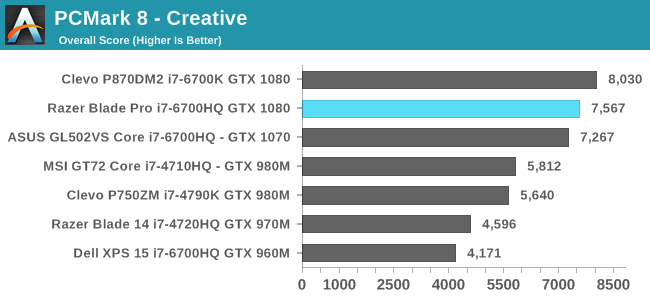
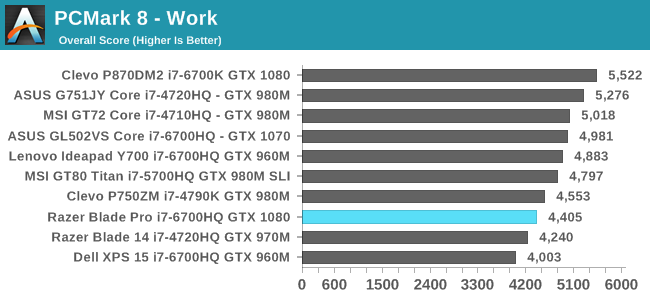
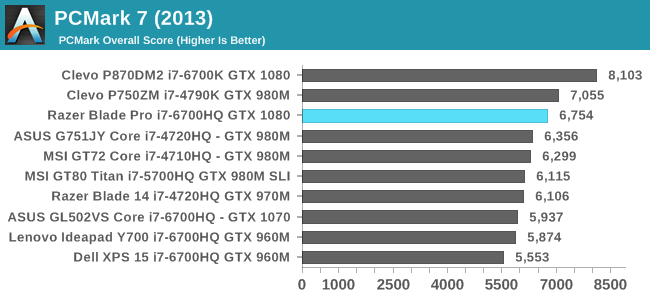
PCMark is a more holistic kind of benchmark than the other tests that we run. Many benchmarks focus on a single component, such as a JavaScript benchmark to evaluate single-threaded CPU performance or a gaming benchmark to characterize GPU performance, but PCMark attempts to measure the performance of a system when considering the interaction of components like the CPU, GPU, RAM, disk speed, etc.
In PCMark 8 the Blade Pro performs well in the Creative test suite, but doesn't perform as well in the Work or Home tests. However, it's important to note that the range of scores is much greater in the Creative test, putting the Blade Pro with its GTX 1080 ahead of most other laptops. In the other two tests the score is on the lower end, but it's still similar to those from other laptops that use i7-6700HQ.
Cinebench
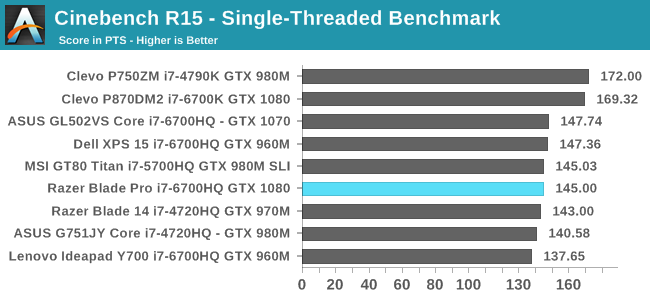
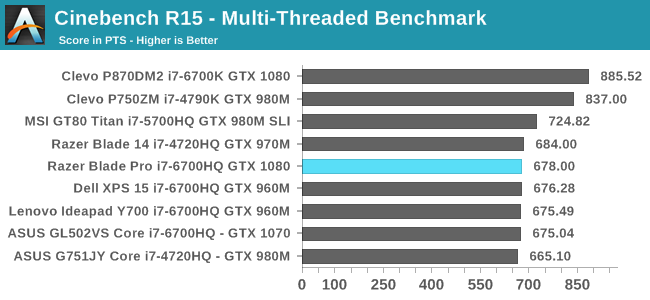
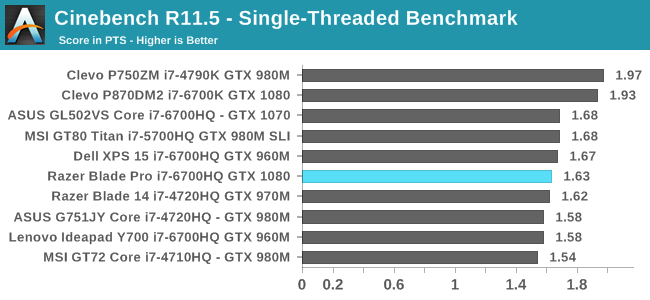
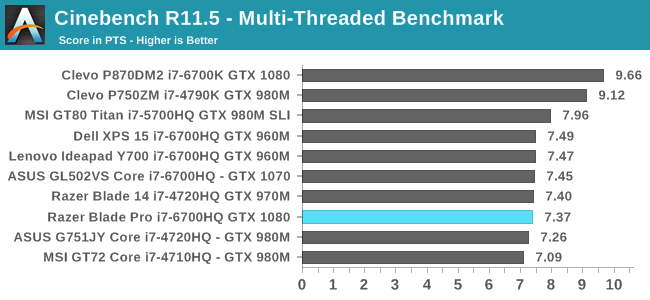
Cinebench is heavily cpu-focused, with both a single-threaded and a multi-threaded test. Previous devices that use Intel's Core i7-6700HQ have fallen in line with roughly the same scores, and the Blade Pro is no exception. However, it's worth noting that those other i7-6700HQ laptops can retail for less than half the price of the Blade Pro, and given the Blade Pro's position as an expensive no-compromise machine, using the 2.9GHz i7-6920HQ would have been a good way to outshine the competition in CPU-focused tasks and benchmarks. So while the Blade Pro does perform as well as similarly specced laptops, you would think that the high price would net you an advantage over the rest of the market.
Web Performance
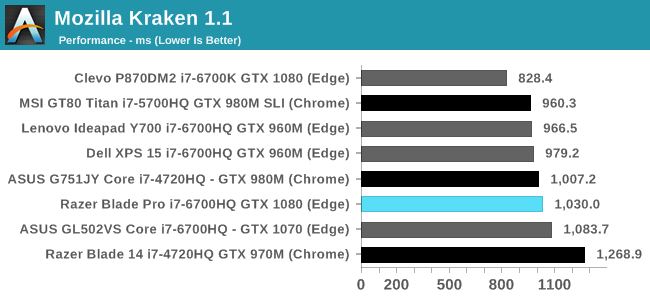

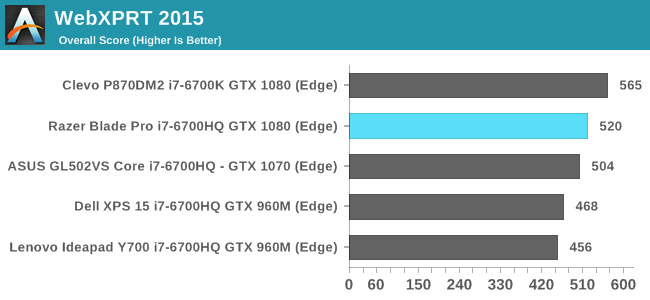
Like the CPU-focused tests, the JavaScript web browsing benchmarks really highlight a device's CPU performance. The testing has evolved here, with the default browser switching from Chrome to Edge when Windows 10 launched, so there is som variance here due to the browser. In this case the Blade Pro is in line with other i7-6700HQ laptops, and with tests like Octane the scores are so high that even a gap of 300 points could simply be due to testing variance.
Storage Performance
The Blade Pro comes in three different storage configurations of 512GB, 1TB, and 2TB. All of these involve two SSDs in a RAID0 configuration. At this point I really need to address this continued nonsensical trend in the gaming machine market. Using two SSDs in RAID0 is not advantageous; it actually presents problems. Using two separate SSDs takes up more space internally, which is at a premium in this kind of machine. It also essentially doubles the failure rate, because you now have two drives that could be a point of failure, and in this setup the loss of one drive is catastrophic. Finally, RAID0 doesn't improve performance in any meaningful way with SSDs. In this scenario the data is striped across both drives, but SSDs already implement multiple forms of parallelism internally, making this mostly pointless when you could just get a larger drive. This kind of setup boils down to marketing driving product decisions, and that's not a framework for good decision making.
Moving on to the actual drives, I've checked on both a 512GB and a 1TB unit that the drives in use are Samsung's PM951. I've heard from other people that their units use PM961, so it's not clear if some sort of multi-sourcing is going on here, but mine are definitely PM951 and I can only evaluate what I'm given. Regardless of whether it's PM951 or PM961, I'm really shocked to see a TLC drive in a $3700 laptop. Frankly, it's just not acceptable. One point I neglected to mention above is that using two separate SSDs in RAID0 instead of a single larger SSD increases the cost by about 20%. So effectively, money is being spent to check a box on a marketing sheet even though it doesn't provide any benefit to the user, when it could be spent on using an altogether better SSD.
At this point SSDs have gotten so fast that you'll usually be bottlenecked by some other part of the system before the IO performance becomes an issue. CrystalDiskMark isn't exactly comprehensive, but it gives a basic idea of SSD performance. Sequential read speeds surpass 2GiB/s, and sequential write speeds surpass 1GiB/s. My complaint is really just based on the fact that such an expensive laptop is shipping with anything but the best available SSDs. In this case the 1TB arrangement of two 512GB PM951s is actually slower with random read and write speeds than the Clevo P870DM2 outfitted with only a 256GB Samsung 950 Pro, despite the 950 Pro's overwhelming disadvantage with the number of dies for use with internal parallelism. For $3699.99 I would expect nothing less than Samsung's SM961, and I'm pretty sure Razer would still make a hefty profit on each unit if they used it.


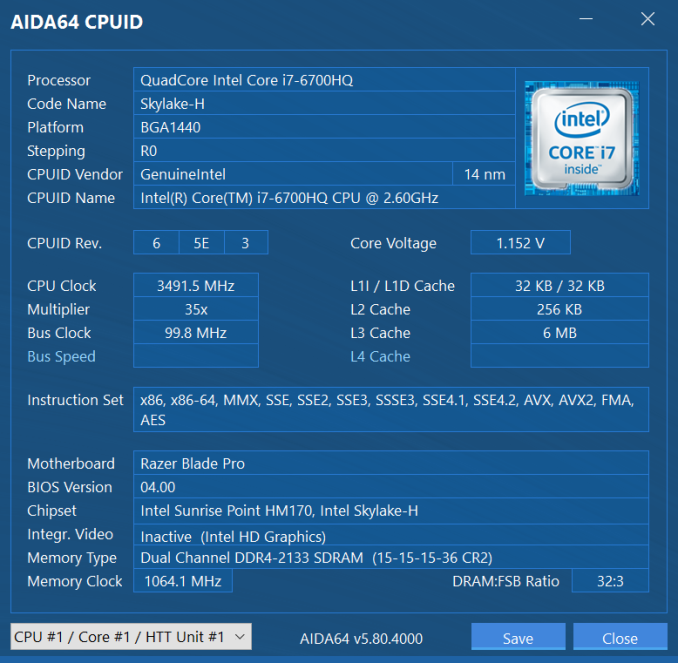
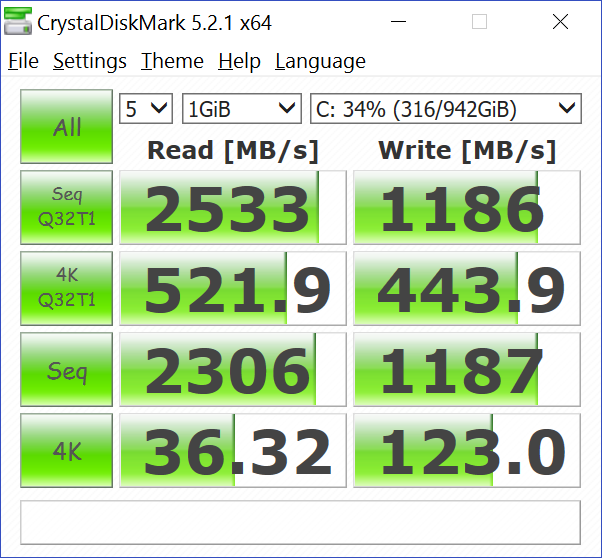








57 Comments
View All Comments
fanofanand - Monday, March 6, 2017 - link
I bought my wife a cheap $350 Acer (because she doesn't know the difference) and despite her repeated attempts, she has been unable to destroy it. Plastic is not premium, but is great when you are building things to a price point. Most consumer electronics sold are not the top-end gear.BrokenCrayons - Monday, March 6, 2017 - link
I think the part I don't like about plastic laptops are those metal-in-plastic screw fittings where there's a little threaded cylinder for the screw that has that knotty outside and get stuffed into a hollow plastic tube. (No idea what the technical name for those things are.) The plastic sometimes will crack around them and the screws along with the threaded cylinder thingies will break free.Barilla - Monday, March 6, 2017 - link
Ok, just to clarify - I have no issue with this laptop being made of aluminium, I even agree it's a good choice, although if I wanted to be picky, there are carbon fibre materials with thermal conductivity equal to or higher than aluminium.I meant it on a more general level as your comment about carbon fibre mentioned Dell XPS, which in it's 13" version houses a 15W CPU and no dGPU, which means it needs to dissipate at most 1/10th the heat this laptop does.
Really, nothing against aluminium. Or magnesium either, as I'm typing this comment from a Surface. All I'm saying is that plastic, and especially carbon fibre, is a perfectly fine material in many - not all - applications, including some laptop and smartphone chassis.
Peace.
Azurael - Monday, March 6, 2017 - link
I wonder whether people will ever get beyond that 'it looks more premium' mindset with CFRP (or even polycarb) vs. metals. Personally, I'd prefer to be able to buy 'plastic' versions of any portable electronics for impact resistance, metal devices are far too easy to dent and break. It's all very well having a metal phone or laptop, but if you have to keep it in a plastic/rubber case all the time to keep it safe, I don't see the point.simonm - Monday, March 6, 2017 - link
Carbon fibre is strong but to the best of my knowledge not usually a good conductor of heat except for certain specialised versions.So unless Razer went with some kind of super carbon fibre the case won't be able to facilitate cooling (like an extended heat sink) as well as if it were aluminium. I doubt Razer did use a high conductivity fibre or they'd be marketing the hell out of that.
Instead they chose it probably for its high strength/rigidity to weight ratio, lower cost than aluminium and marketing because it sounds cool and high end.
If money (and weight) wasn't an option you could use lots of metal alloys that are more conductive than aluminium. Copper... gold ;)
simonm - Monday, March 6, 2017 - link
Correction: change option to issue!PS: So I think most people are looking down on the CF for its thermal properties when compared with aluminium. Aluminium offers good weight and thermal properties but with high expense and lower hardness/rigidity than carbon fibre.
With a 1080 packed in there and a 180 W power adapter I reckon you'd want as much help dissipating heat as you can get. So carbon fibre seems like something of a compromise.
colonelclaw - Monday, March 6, 2017 - link
Surely carbon fibre is much more expensive than aluminium? That's the impression I always got from products that use it, or is that just marketing?fanofanand - Monday, March 6, 2017 - link
Carbon Fiber (the high-tech variety) is far more expensive than aluminum.Bullwinkle J Moose - Monday, March 6, 2017 - link
if money (and weight) wasn't an option.....Diamond plated Silver would be a far better thermal conductor than Copper or Gold
Diamond has 3X the thermal conductivity of even silver
But a diamond frost coat on copper would look better
A Rose Gold that costs as much as real Gold
Sound like an Apple Product!
SkipPerk - Wednesday, April 19, 2017 - link
In order to plate the silver to make it strong enough I think it would interfere with the thermal transfer. I think nickel-plated copper would be the better choice, although it would still be soft. Aluminum really is the best choice.